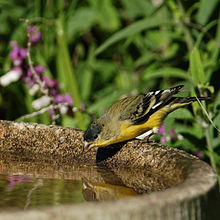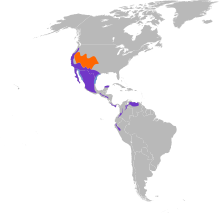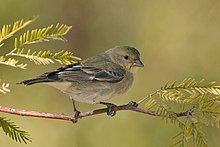Lesser goldfinch
| Lesser goldfinch | |
|---|---|

| |
| Intermediate male; note mottled back and cap | |
| Scientific classification | |
| Kingdom: | Animalia |
| Phylum: | Chordata |
| Class: | Aves |
| Order: | Passeriformes |
| Family: | Fringillidae |
| Subfamily: | Carduelinae |
| Genus: | Spinus |
| Species: | S. psaltria
|
| Binomial name | |
| Spinus psaltria (Say, 1822)
| |
| Subspecies | |
|
see text | |

| |
| Synonyms | |
|
Fringilla psaltria (protonym) | |
The lesser goldfinch (Spinus psaltria) is a very small songbird of the Americas. Together with its relatives the American goldfinch and Lawrence's goldfinch, it forms the American goldfinches clade in the genus Spinus sensu stricto.
The American goldfinches can be distinguished by the males having a black (rarely green) forehead, whereas the latter is (like the rest of the face) red or yellow in the European goldfinch and its relatives. North American males are markedly polymorphic and five subspecies are often named; at least two of them seem to represent a less-progressed stage in evolution, however.
Taxonomy[]
The lesser goldfinch was formally described by the American zoologist Thomas Say in 1822 under the binomial name Fringilla psaltria.[2] The specific epithet psaltria is Ancient Greek for a female harpist.[3] The type locality is Colorado Springs, Colorado.[4] The lesser goldfinch is now placed in the genus Spinus that was introduced in 1816 by the German naturalist Carl Ludwig Koch.[5][6]
Five subspecies are recognised:[6]
- S. p. hesperophilus (Oberholser, 1903) – west USA and northwest Mexico
- S. p. witti Grant, PR, 1964 – Tres Marias Islands (off west Mexico)
- S. p. psaltria (Say, 1822) – west-central USA to south-central Mexico
- S. p. jouyi (Ridgway, 1898) – southeast Mexico and northwest Belize
- S. p. colombianus (Lafresnaye, 1843) – south Mexico to Peru and Venezuela
Description[]
This petite species is not only the smallest North American Spinus finch, it may be the smallest true finch in the world.[7][8] Some sources list more subtropical Spinus species as slightly smaller on average, including the Andean siskin (Spinus spinescens).[9] This species ranges from 9 to 12 cm (3.5 to 4.7 in) in length and can weigh from 8 to 11.5 g (0.28 to 0.41 oz).[9][10][11] Among standard measurements, the wing chord is 5.5 to 7 cm (2.2 to 2.8 in), the tail is 3.9 to 4.7 cm (1.5 to 1.9 in), the bill is 0.9 to 1.1 cm (0.35 to 0.43 in) and the tarsus is 1.1 to 1.2 cm (0.43 to 0.47 in).[9] There is a slight northwest-southeast cline in size, with the largest birds from Mexico and further south being up to one-fifth larger than the smallest from the extreme northwest of its range; this effect is more pronounced in females. There is also considerable variation in the amount of black on the head and back in males and thus five subspecies have been proposed. But this variation, too, seems to be simple and clinal changes in allele frequency and thus the "subspecies" might be better considered colour morphs or geographic forms.[12]

Males are easily recognized by their bright yellow underparts and big white patches in the tail (outer rectrices) and on the wings (the base of the primaries). They range from having solid black from the back to the upper head including the ear-coverts to having these regions medium green; each of the back, crown and ear regions varies in darkness rather independently though; as a rule, the ears are not darker than the rest. In most of the range, dark birds termed psaltria (the Arkansas black-backed goldfinch) predominate. The light birds are termed hesperophilus (the green-backed goldfinch) and are most common in the far western U.S. and northwestern Mexico.[12]
The zone in which both light and dark males occur on a regular basis is broadest in the north and extends across the width of the Rocky Mountains and the Sierra Madre Occidental ranges. It reaches the Pacific Coast in southern Sonora to northern Sinaloa, roughly between the area of Ciudad Obregón to Culiacán. In the United States, the most diverse array of phenotypes can be found in Colorado and New Mexico. East of the 106th meridian west in southwestern Texas, as well as in most of Mexico, almost all males have black backs. S. p. colombianus, found east and south of the Isthmus of Tehuantepec, is a richer yellow below in males. This subspecies, as well as the even yellower S. p. jouyi from the Yucatán Peninsula and adjacent regions of Mexico and S. p. witti from the Tres Marías Islands off Nayarit[13] require more study, especially since at least the former two also seem to be significantly larger and longer-billed.[12]

Females' and immatures' upperparts are more or less grayish olive-green; their underparts are yellowish, buffier in immatures. They have only a narrow strip of white on the wings (with other white markings in some forms) and little or no white on the tail. They are best distinguished from other members of the genus by the combination of small size, upperparts without white or yellow, and dark gray bill. In all plumages, this bird can easily be taken for a New World warbler if the typical finch bill is not seen well.
Like other goldfinches, it has an undulating flight in which it frequently gives a call: in this case, a harsh chig chig chig.[14] Another distinctive call is a very high-pitched, drawn-out whistle, often rising from one level pitch to another (teeeyeee) or falling (teeeyooo). The song is a prolonged warble or twitter, more phrased than that of the American goldfinch,[15] often incorporating imitations of other species.
S. p. hesperophilus at Desert Botanical Garden, Phoenix
Distribution and habitat[]

This American goldfinch ranges from the southwestern United States (near the coast, as far north as extreme southwestern Washington) to Venezuela and Peru. It migrates from the colder parts of its U.S. range.
The lesser goldfinch often occurs in flocks or at least loose associations. It utilizes almost any habitat with trees or shrubs except for dense forest, and is common and conspicuous in many areas, often coming near houses. It is common at feeders in the Southwest United States and will come almost anywhere with thistle sock feeders. Flocks of at least six birds will often be seen at feeders. It feeds mostly on tree buds and weed seeds; geophagy has been observed in this species.[16]
The nesting season is in summer in the temperate parts of its range; in the tropics it apparently breeds all-year round, perhaps less often in September and October.[17] It lays three or four bluish white eggs in a cup nest made of fine plant materials such as lichens, rootlets, and strips of bark, placed in a bush or at low or middle levels in a tree.
The moult occurs in two different patterns which coincide with the blackness of the upperparts quite well. Here too is a broad zone of intergradation. Pacific birds moult after breeding, and females shed a few body feathers before breeding too. Juvenile males shed more remiges than females when moulting into adult plumage. East of the 106th meridian west, birds moult strongly before breeding and replace another quantity of feathers afterwards, and post-juvenal moult does not differ significantly between the sexes. However, this seems dependent on the differing rainfall regimes; simply put, birds at least anywhere in the North American range moult most of their plumage at the end of the dry season and may replace more feathers at the end of the wet season.[12]
Considered a Species of Least Concern by the IUCN due to its vast range, it nonetheless seems to be declining locally. For example, it is rare in the Ecuadorean Andes foothills.[17]
References[]
- ^ BirdLife International (2012). "Carduelis psaltria". IUCN Red List of Threatened Species. 2012. Retrieved 26 November 2013.
- ^ Say, Thomas (1823). "Animals — Sioux and Omawhaw Indians — Winter residence". In James, Edwin (ed.). Account of an expedition from Pittsburgh to the Rocky Mountains, performed in the years 1819 and '20 : by order of the Hon. J.C. Calhoun, sec'y of war: under the command of Major Stephen H. Long. From the notes of Major Long, Mr. T. Say, and other gentlemen of the exploring party. Volume 2. Philadelphia: H.C. Carey and I. Lea. p. 40, note.
|volume=has extra text (help) Although the year is given as 1823 on the title page, the volume was actually published on 31 December 1822. See: Woodman, Neal (2010). "History and dating of the publication of the Philadelphia (1822) and London (1823) editions of Edwin James's Account of an expedition from Pittsburgh to the Rocky Mountains". Archives of Natural History. 37 (1): 28–38. doi:10.3366/E0260954109001636. - ^ Jobling, James A. (2010). The Helm Dictionary of Scientific Bird Names. London: Christopher Helm. p. 319. ISBN 978-1-4081-2501-4.
- ^ Paynter, Raymond A. Jr, ed. (1968). Check-List of Birds of the World. Volume 14. Cambridge, Massachusetts: Museum of Comparative Zoology. p. 246-247.
|volume=has extra text (help) - ^ Koch, Carl Ludwig (1816). System der baierischen Zoologie, Volume 1 (in German). Nürnberg. p. 232.
- ^ Jump up to: a b Gill, Frank; Donsker, David; Rasmussen, Pamela, eds. (2020). "Finches, euphonias". IOC World Bird List Version 10.2. International Ornithologists' Union. Retrieved 13 October 2020.
- ^ Peterson et al. (1990), Sibley (2000)
- ^ Hilty, Steven L., Birds of Venezuela, 2002, Princeton University Press
- ^ Jump up to: a b c Finches and Sparrows by Peter Clement. Princeton University Press (1999). ISBN 978-0691048789.
- ^ Birds of the World blog
- ^ CRC Handbook of Avian Body Masses by John B. Dunning Jr. (Editor). CRC Press (1992), ISBN 978-0-8493-4258-5.
- ^ Jump up to: a b c d Willoughby (2007)
- ^ Quatro (2007)
- ^ Sibley (2000)
- ^ Peterson et al. (1990)
- ^ Delgado-V. (2006)
- ^ Jump up to: a b Cisneros-Heredia (2006)
Sources[]
- Cisneros-Heredia, Diego F. (2006): "Notes on breeding, behaviour and distribution of some birds in Ecuador." Bulletin of the British Ornithologists' Club 126 (2): 153–164. PDF fulltext
- Delgado-V., Carlos A. (2006): "Observación de geofagia por el Jiguero Aliblanco Carduelis psaltria (Fringillidae)." ["Report of geophagy in the Lesser Goldfinch C. psaltria (Fringillidae)".] Boletín de la Sociedad Antioqueña de Ornitología 16 (2): 31–34. [Spanish with English abstract] PDF fulltext
- Howell, Steven N.G. & Webb, Sophie (1995): A Guide to the Birds of Mexico and Northern Central America. Oxford University Press, Oxford & New York. ISBN 0-19-854012-4
- Peterson, Roger Tory; Peterson, Virginia Marie; National Audubon Society; National Wildlife Federation & Roger Tory Peterson Institute (1990): A field guide to western birds: a completely new guide to field marks of all species found in North America west of the 100th meridian and north of Mexico. Houghton Mifflin, Boston. ISBN 0-395-51424-X
- Quatro, John (2007): Siskins of the World. Retrieved January 10, 2008.
- Sibley, David Allen (2000): The Sibley Guide to Birds. Alfred A. Knopf, New York. ISBN 0-679-45122-6
- Willoughby, Ernest J. (2007): Geographic variation in color, measurements, and molt of the Lesser Goldfinch in North America does not support subspecific designation [English with Spanish abstract]. The Condor 109 (2): 419–436. doi:10.1650/0010-5422(2007)109[419:GVICMA]2.0.CO;2
External links[]
| Wikimedia Commons has media related to Spinus psaltria. |
| Wikispecies has information related to Carduelis psaltria. |
- Lesser goldfinch Species Account - Cornell Lab of Ornithology
- Lesser goldfinch - Carduelis psaltria - USGS Patuxent Bird Identification InfoCenter
- "Lesser goldfinch media". Internet Bird Collection.
- Lesser goldfinch photo gallery at VIREO (Drexel University)
- Interactive range map of Carduelis psaltria at IUCN Red List maps
- IUCN Red List least concern species
- Birds described in 1823
- Birds of Central America
- Birds of the Northern Andes
- Fauna of the California chaparral and woodlands
- Least concern biota of North America
- Least concern biota of the United States
- Native birds of the Southwestern United States
- Native birds of the Western United States
- Spinus (genus)
- Taxa named by Thomas Say

